Psychosocial Development: Bullying, Health, and Well-being
VerifiedAdded on 2022/12/09
|6
|1777
|470
Essay
AI Summary
This essay delves into psychosocial development across the lifespan, examining the various stages of human development from birth to death, and exploring the psychological changes individuals experience. The primary focus is on the impact of bullying during adolescence (ages 11-20), analyzing its effects on health-related issues and overall well-being. The essay highlights that bullying, encompassing both verbal and physical abuse, significantly affects children, leading to mental health issues such as anxiety, depression, and even suicidal tendencies. It also explores how professionals like counselors and psychologists can intervene by collecting data, advising families and educators, collaborating with teachers, and providing counseling to both victims and perpetrators. The essay references various studies to support its claims and emphasizes the importance of recognizing and addressing the long-term consequences of bullying to promote a safe and supportive environment for children and adolescents.
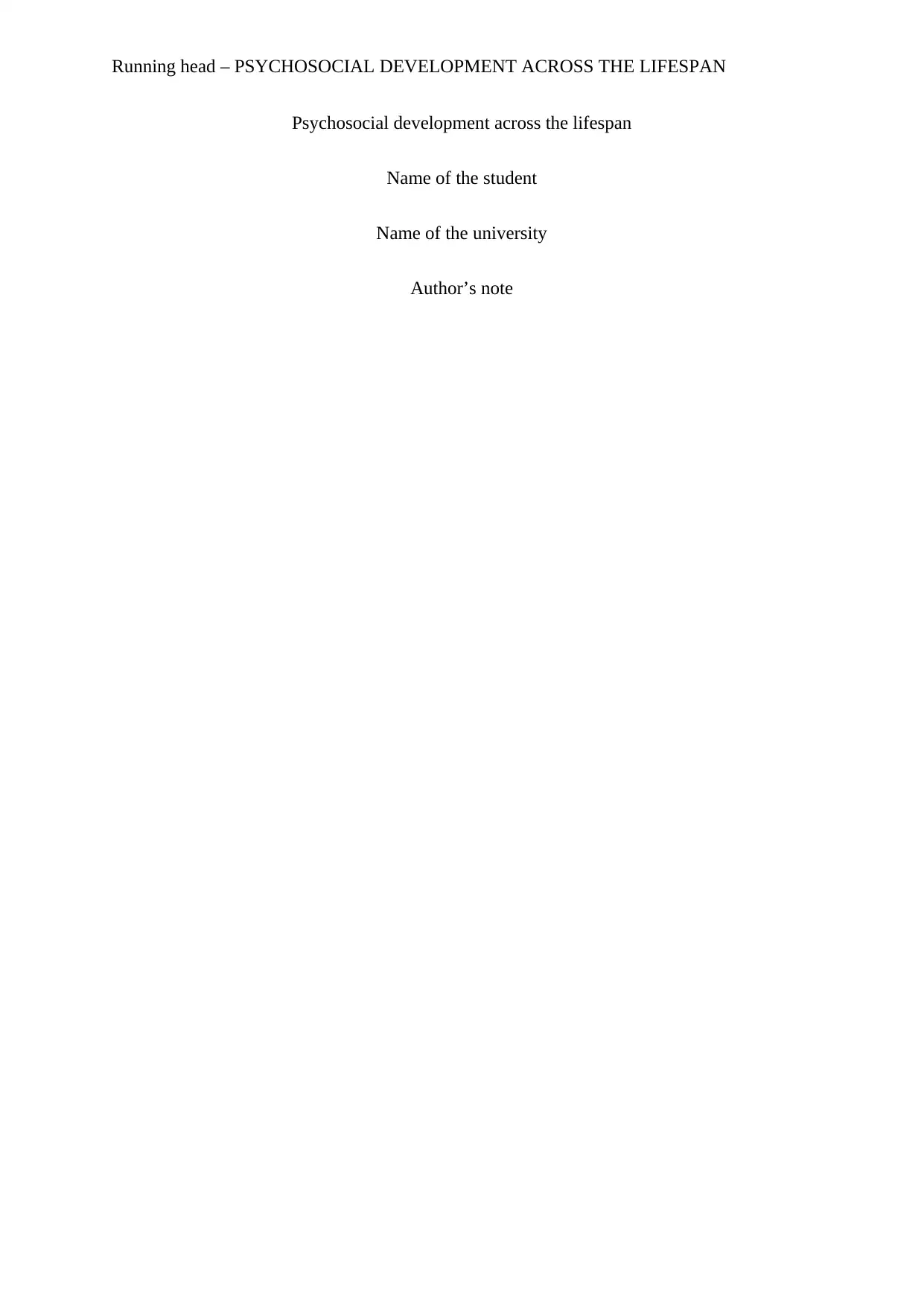
Running head – PSYCHOSOCIAL DEVELOPMENT ACROSS THE LIFESPAN
Psychosocial development across the lifespan
Name of the student
Name of the university
Author’s note
Psychosocial development across the lifespan
Name of the student
Name of the university
Author’s note
Paraphrase This Document
Need a fresh take? Get an instant paraphrase of this document with our AI Paraphraser
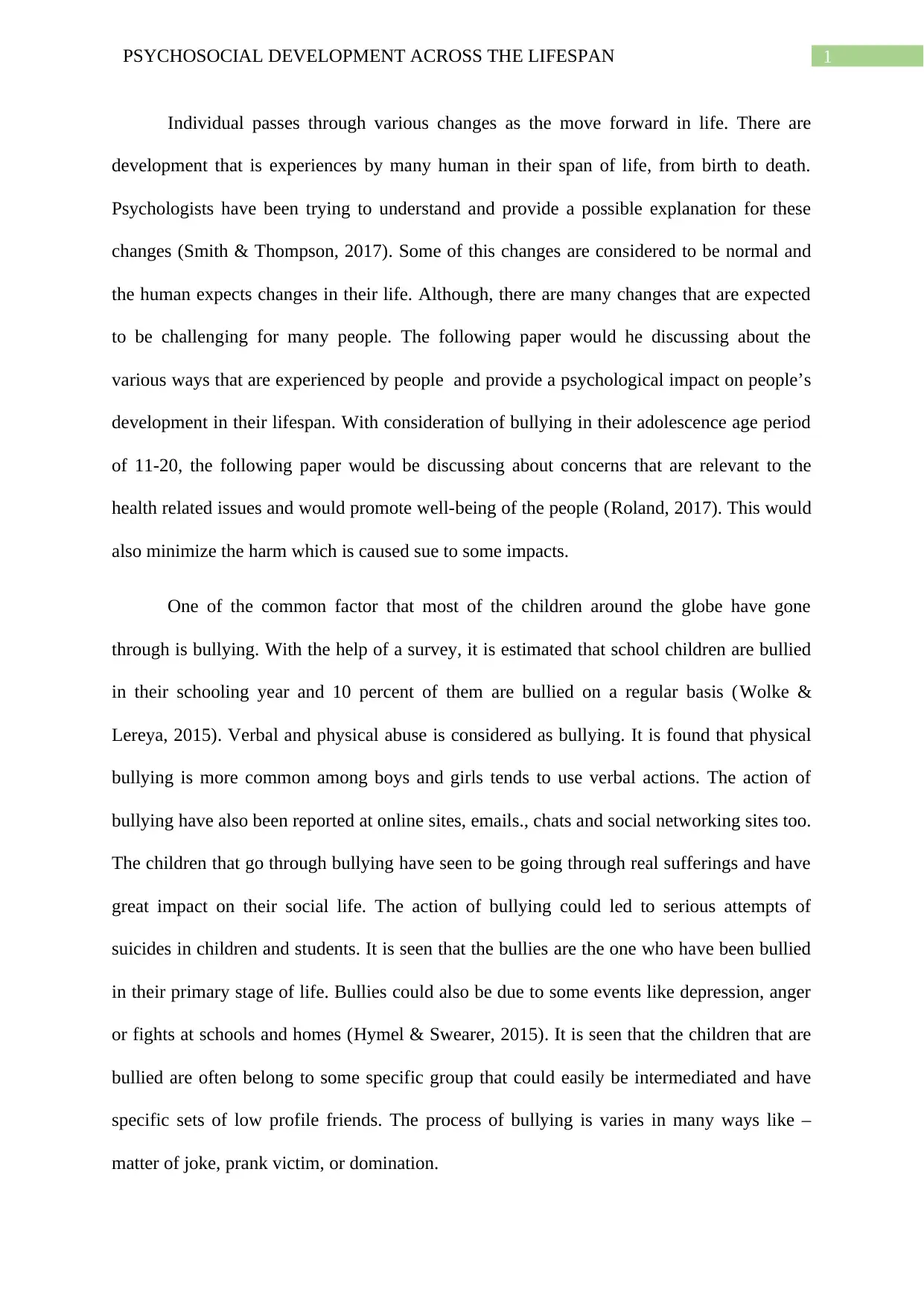
1PSYCHOSOCIAL DEVELOPMENT ACROSS THE LIFESPAN
Individual passes through various changes as the move forward in life. There are
development that is experiences by many human in their span of life, from birth to death.
Psychologists have been trying to understand and provide a possible explanation for these
changes (Smith & Thompson, 2017). Some of this changes are considered to be normal and
the human expects changes in their life. Although, there are many changes that are expected
to be challenging for many people. The following paper would he discussing about the
various ways that are experienced by people and provide a psychological impact on people’s
development in their lifespan. With consideration of bullying in their adolescence age period
of 11-20, the following paper would be discussing about concerns that are relevant to the
health related issues and would promote well-being of the people (Roland, 2017). This would
also minimize the harm which is caused sue to some impacts.
One of the common factor that most of the children around the globe have gone
through is bullying. With the help of a survey, it is estimated that school children are bullied
in their schooling year and 10 percent of them are bullied on a regular basis (Wolke &
Lereya, 2015). Verbal and physical abuse is considered as bullying. It is found that physical
bullying is more common among boys and girls tends to use verbal actions. The action of
bullying have also been reported at online sites, emails., chats and social networking sites too.
The children that go through bullying have seen to be going through real sufferings and have
great impact on their social life. The action of bullying could led to serious attempts of
suicides in children and students. It is seen that the bullies are the one who have been bullied
in their primary stage of life. Bullies could also be due to some events like depression, anger
or fights at schools and homes (Hymel & Swearer, 2015). It is seen that the children that are
bullied are often belong to some specific group that could easily be intermediated and have
specific sets of low profile friends. The process of bullying is varies in many ways like –
matter of joke, prank victim, or domination.
Individual passes through various changes as the move forward in life. There are
development that is experiences by many human in their span of life, from birth to death.
Psychologists have been trying to understand and provide a possible explanation for these
changes (Smith & Thompson, 2017). Some of this changes are considered to be normal and
the human expects changes in their life. Although, there are many changes that are expected
to be challenging for many people. The following paper would he discussing about the
various ways that are experienced by people and provide a psychological impact on people’s
development in their lifespan. With consideration of bullying in their adolescence age period
of 11-20, the following paper would be discussing about concerns that are relevant to the
health related issues and would promote well-being of the people (Roland, 2017). This would
also minimize the harm which is caused sue to some impacts.
One of the common factor that most of the children around the globe have gone
through is bullying. With the help of a survey, it is estimated that school children are bullied
in their schooling year and 10 percent of them are bullied on a regular basis (Wolke &
Lereya, 2015). Verbal and physical abuse is considered as bullying. It is found that physical
bullying is more common among boys and girls tends to use verbal actions. The action of
bullying have also been reported at online sites, emails., chats and social networking sites too.
The children that go through bullying have seen to be going through real sufferings and have
great impact on their social life. The action of bullying could led to serious attempts of
suicides in children and students. It is seen that the bullies are the one who have been bullied
in their primary stage of life. Bullies could also be due to some events like depression, anger
or fights at schools and homes (Hymel & Swearer, 2015). It is seen that the children that are
bullied are often belong to some specific group that could easily be intermediated and have
specific sets of low profile friends. The process of bullying is varies in many ways like –
matter of joke, prank victim, or domination.
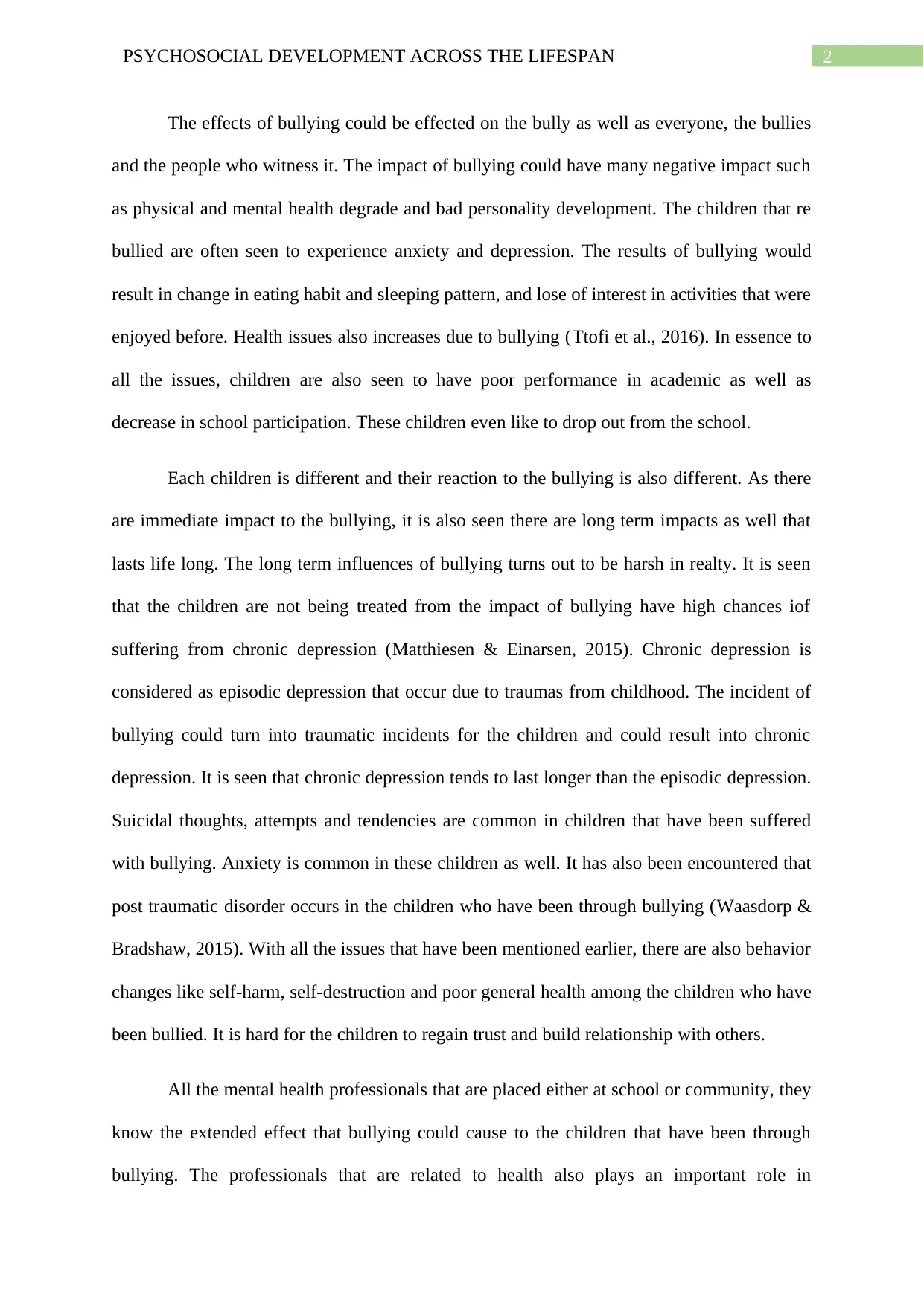
2PSYCHOSOCIAL DEVELOPMENT ACROSS THE LIFESPAN
The effects of bullying could be effected on the bully as well as everyone, the bullies
and the people who witness it. The impact of bullying could have many negative impact such
as physical and mental health degrade and bad personality development. The children that re
bullied are often seen to experience anxiety and depression. The results of bullying would
result in change in eating habit and sleeping pattern, and lose of interest in activities that were
enjoyed before. Health issues also increases due to bullying (Ttofi et al., 2016). In essence to
all the issues, children are also seen to have poor performance in academic as well as
decrease in school participation. These children even like to drop out from the school.
Each children is different and their reaction to the bullying is also different. As there
are immediate impact to the bullying, it is also seen there are long term impacts as well that
lasts life long. The long term influences of bullying turns out to be harsh in realty. It is seen
that the children are not being treated from the impact of bullying have high chances iof
suffering from chronic depression (Matthiesen & Einarsen, 2015). Chronic depression is
considered as episodic depression that occur due to traumas from childhood. The incident of
bullying could turn into traumatic incidents for the children and could result into chronic
depression. It is seen that chronic depression tends to last longer than the episodic depression.
Suicidal thoughts, attempts and tendencies are common in children that have been suffered
with bullying. Anxiety is common in these children as well. It has also been encountered that
post traumatic disorder occurs in the children who have been through bullying (Waasdorp &
Bradshaw, 2015). With all the issues that have been mentioned earlier, there are also behavior
changes like self-harm, self-destruction and poor general health among the children who have
been bullied. It is hard for the children to regain trust and build relationship with others.
All the mental health professionals that are placed either at school or community, they
know the extended effect that bullying could cause to the children that have been through
bullying. The professionals that are related to health also plays an important role in
The effects of bullying could be effected on the bully as well as everyone, the bullies
and the people who witness it. The impact of bullying could have many negative impact such
as physical and mental health degrade and bad personality development. The children that re
bullied are often seen to experience anxiety and depression. The results of bullying would
result in change in eating habit and sleeping pattern, and lose of interest in activities that were
enjoyed before. Health issues also increases due to bullying (Ttofi et al., 2016). In essence to
all the issues, children are also seen to have poor performance in academic as well as
decrease in school participation. These children even like to drop out from the school.
Each children is different and their reaction to the bullying is also different. As there
are immediate impact to the bullying, it is also seen there are long term impacts as well that
lasts life long. The long term influences of bullying turns out to be harsh in realty. It is seen
that the children are not being treated from the impact of bullying have high chances iof
suffering from chronic depression (Matthiesen & Einarsen, 2015). Chronic depression is
considered as episodic depression that occur due to traumas from childhood. The incident of
bullying could turn into traumatic incidents for the children and could result into chronic
depression. It is seen that chronic depression tends to last longer than the episodic depression.
Suicidal thoughts, attempts and tendencies are common in children that have been suffered
with bullying. Anxiety is common in these children as well. It has also been encountered that
post traumatic disorder occurs in the children who have been through bullying (Waasdorp &
Bradshaw, 2015). With all the issues that have been mentioned earlier, there are also behavior
changes like self-harm, self-destruction and poor general health among the children who have
been bullied. It is hard for the children to regain trust and build relationship with others.
All the mental health professionals that are placed either at school or community, they
know the extended effect that bullying could cause to the children that have been through
bullying. The professionals that are related to health also plays an important role in
⊘ This is a preview!⊘
Do you want full access?
Subscribe today to unlock all pages.

Trusted by 1+ million students worldwide
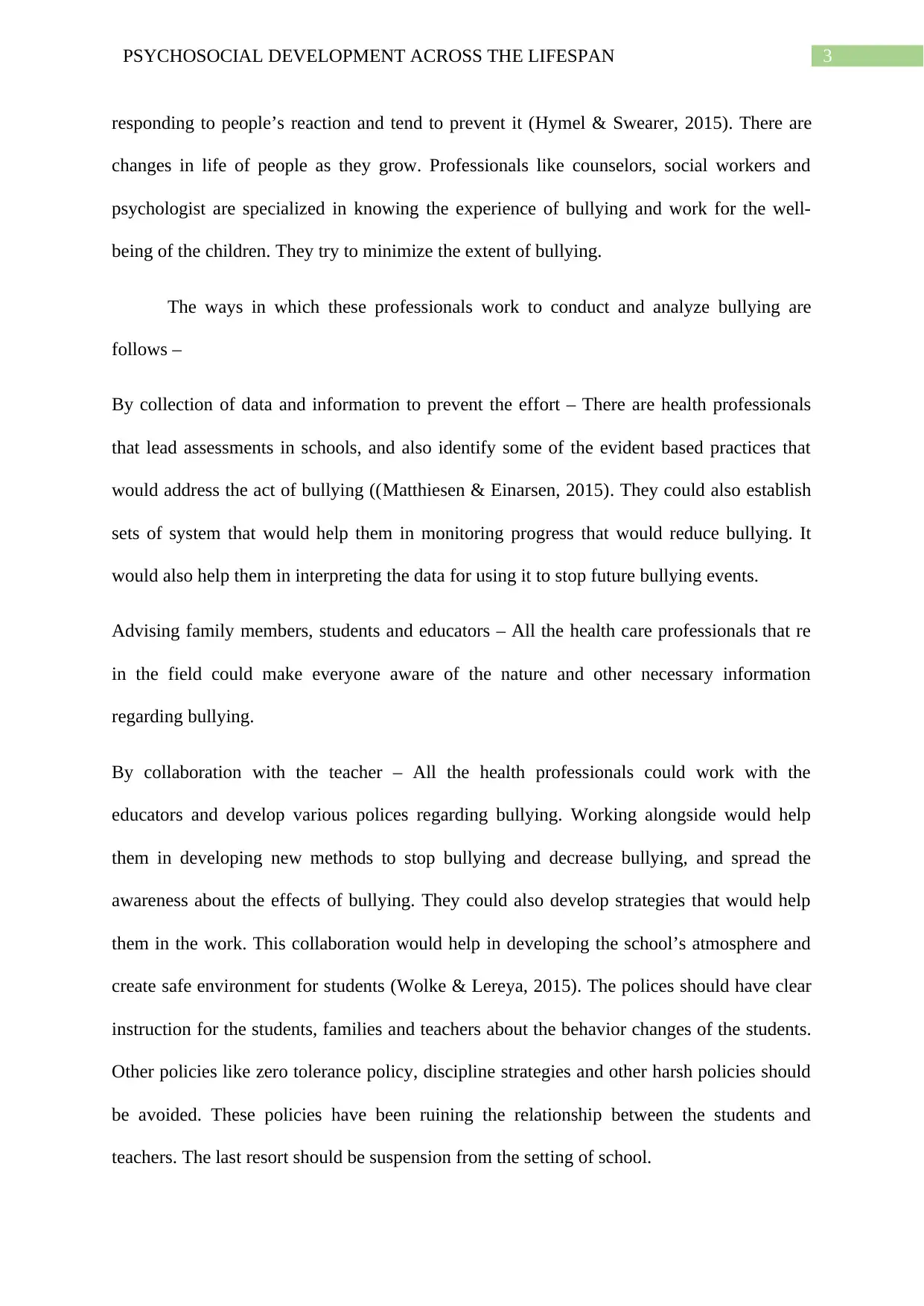
3PSYCHOSOCIAL DEVELOPMENT ACROSS THE LIFESPAN
responding to people’s reaction and tend to prevent it (Hymel & Swearer, 2015). There are
changes in life of people as they grow. Professionals like counselors, social workers and
psychologist are specialized in knowing the experience of bullying and work for the well-
being of the children. They try to minimize the extent of bullying.
The ways in which these professionals work to conduct and analyze bullying are
follows –
By collection of data and information to prevent the effort – There are health professionals
that lead assessments in schools, and also identify some of the evident based practices that
would address the act of bullying ((Matthiesen & Einarsen, 2015). They could also establish
sets of system that would help them in monitoring progress that would reduce bullying. It
would also help them in interpreting the data for using it to stop future bullying events.
Advising family members, students and educators – All the health care professionals that re
in the field could make everyone aware of the nature and other necessary information
regarding bullying.
By collaboration with the teacher – All the health professionals could work with the
educators and develop various polices regarding bullying. Working alongside would help
them in developing new methods to stop bullying and decrease bullying, and spread the
awareness about the effects of bullying. They could also develop strategies that would help
them in the work. This collaboration would help in developing the school’s atmosphere and
create safe environment for students (Wolke & Lereya, 2015). The polices should have clear
instruction for the students, families and teachers about the behavior changes of the students.
Other policies like zero tolerance policy, discipline strategies and other harsh policies should
be avoided. These policies have been ruining the relationship between the students and
teachers. The last resort should be suspension from the setting of school.
responding to people’s reaction and tend to prevent it (Hymel & Swearer, 2015). There are
changes in life of people as they grow. Professionals like counselors, social workers and
psychologist are specialized in knowing the experience of bullying and work for the well-
being of the children. They try to minimize the extent of bullying.
The ways in which these professionals work to conduct and analyze bullying are
follows –
By collection of data and information to prevent the effort – There are health professionals
that lead assessments in schools, and also identify some of the evident based practices that
would address the act of bullying ((Matthiesen & Einarsen, 2015). They could also establish
sets of system that would help them in monitoring progress that would reduce bullying. It
would also help them in interpreting the data for using it to stop future bullying events.
Advising family members, students and educators – All the health care professionals that re
in the field could make everyone aware of the nature and other necessary information
regarding bullying.
By collaboration with the teacher – All the health professionals could work with the
educators and develop various polices regarding bullying. Working alongside would help
them in developing new methods to stop bullying and decrease bullying, and spread the
awareness about the effects of bullying. They could also develop strategies that would help
them in the work. This collaboration would help in developing the school’s atmosphere and
create safe environment for students (Wolke & Lereya, 2015). The polices should have clear
instruction for the students, families and teachers about the behavior changes of the students.
Other policies like zero tolerance policy, discipline strategies and other harsh policies should
be avoided. These policies have been ruining the relationship between the students and
teachers. The last resort should be suspension from the setting of school.
Paraphrase This Document
Need a fresh take? Get an instant paraphrase of this document with our AI Paraphraser
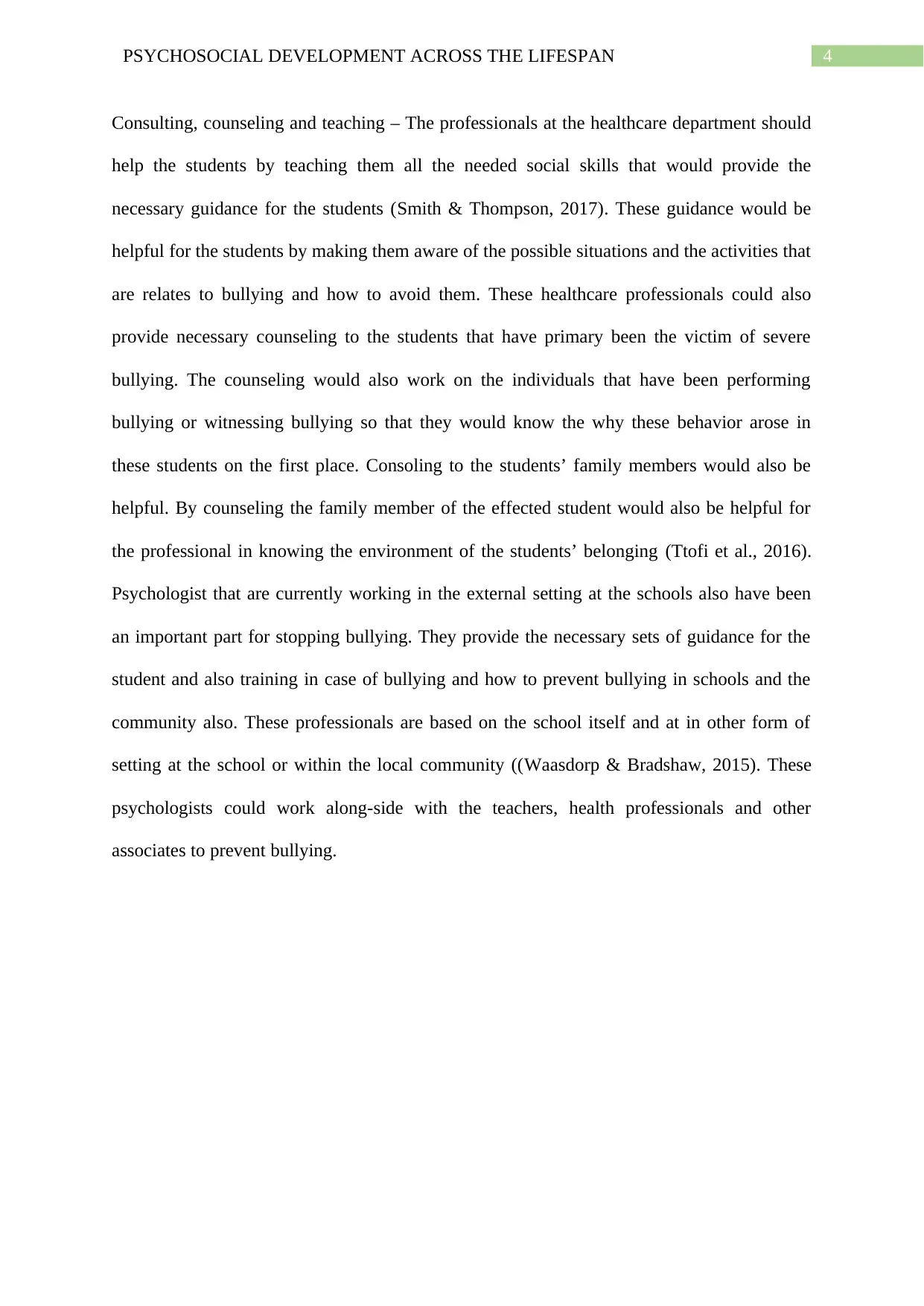
4PSYCHOSOCIAL DEVELOPMENT ACROSS THE LIFESPAN
Consulting, counseling and teaching – The professionals at the healthcare department should
help the students by teaching them all the needed social skills that would provide the
necessary guidance for the students (Smith & Thompson, 2017). These guidance would be
helpful for the students by making them aware of the possible situations and the activities that
are relates to bullying and how to avoid them. These healthcare professionals could also
provide necessary counseling to the students that have primary been the victim of severe
bullying. The counseling would also work on the individuals that have been performing
bullying or witnessing bullying so that they would know the why these behavior arose in
these students on the first place. Consoling to the students’ family members would also be
helpful. By counseling the family member of the effected student would also be helpful for
the professional in knowing the environment of the students’ belonging (Ttofi et al., 2016).
Psychologist that are currently working in the external setting at the schools also have been
an important part for stopping bullying. They provide the necessary sets of guidance for the
student and also training in case of bullying and how to prevent bullying in schools and the
community also. These professionals are based on the school itself and at in other form of
setting at the school or within the local community ((Waasdorp & Bradshaw, 2015). These
psychologists could work along-side with the teachers, health professionals and other
associates to prevent bullying.
Consulting, counseling and teaching – The professionals at the healthcare department should
help the students by teaching them all the needed social skills that would provide the
necessary guidance for the students (Smith & Thompson, 2017). These guidance would be
helpful for the students by making them aware of the possible situations and the activities that
are relates to bullying and how to avoid them. These healthcare professionals could also
provide necessary counseling to the students that have primary been the victim of severe
bullying. The counseling would also work on the individuals that have been performing
bullying or witnessing bullying so that they would know the why these behavior arose in
these students on the first place. Consoling to the students’ family members would also be
helpful. By counseling the family member of the effected student would also be helpful for
the professional in knowing the environment of the students’ belonging (Ttofi et al., 2016).
Psychologist that are currently working in the external setting at the schools also have been
an important part for stopping bullying. They provide the necessary sets of guidance for the
student and also training in case of bullying and how to prevent bullying in schools and the
community also. These professionals are based on the school itself and at in other form of
setting at the school or within the local community ((Waasdorp & Bradshaw, 2015). These
psychologists could work along-side with the teachers, health professionals and other
associates to prevent bullying.
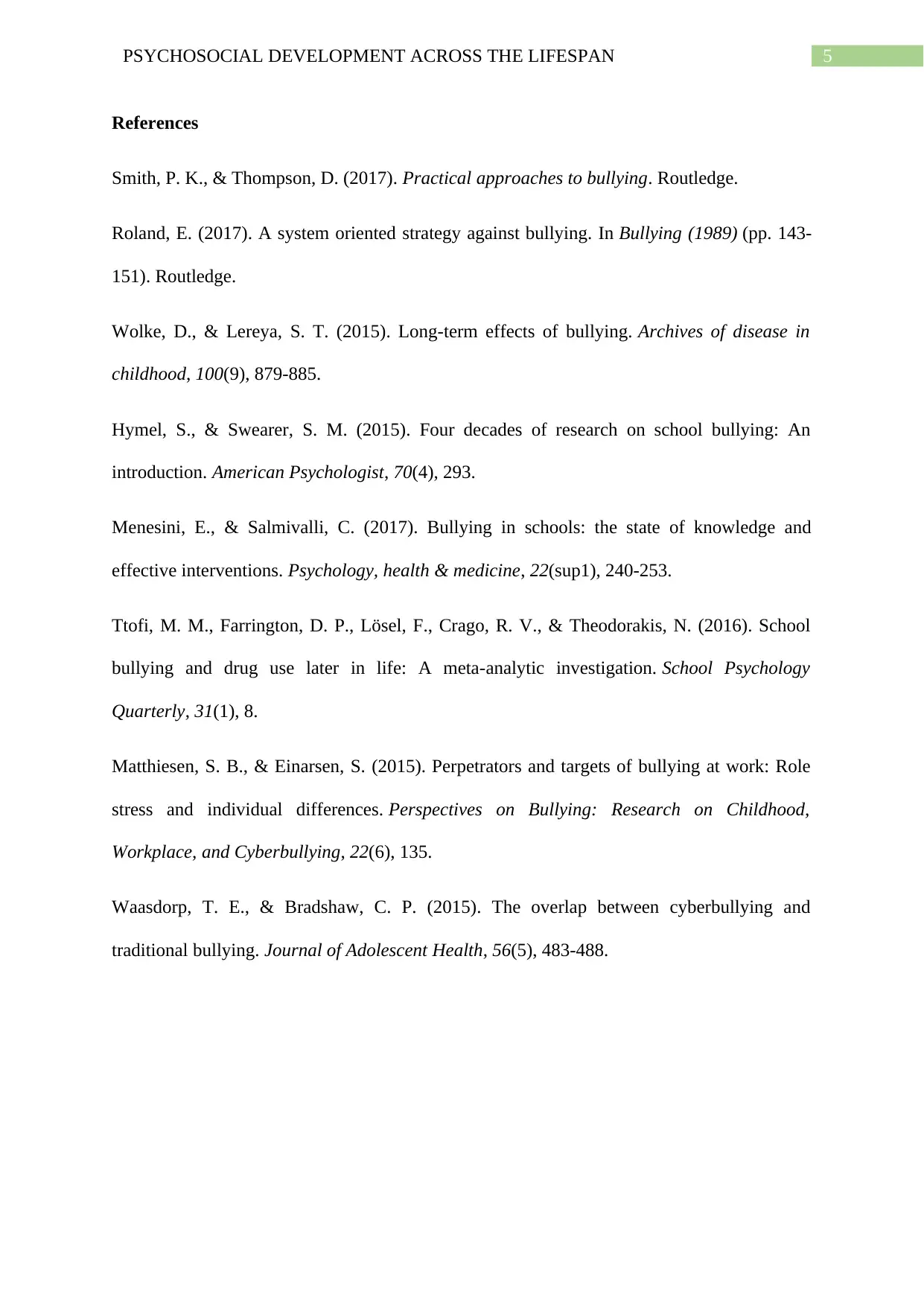
5PSYCHOSOCIAL DEVELOPMENT ACROSS THE LIFESPAN
References
Smith, P. K., & Thompson, D. (2017). Practical approaches to bullying. Routledge.
Roland, E. (2017). A system oriented strategy against bullying. In Bullying (1989) (pp. 143-
151). Routledge.
Wolke, D., & Lereya, S. T. (2015). Long-term effects of bullying. Archives of disease in
childhood, 100(9), 879-885.
Hymel, S., & Swearer, S. M. (2015). Four decades of research on school bullying: An
introduction. American Psychologist, 70(4), 293.
Menesini, E., & Salmivalli, C. (2017). Bullying in schools: the state of knowledge and
effective interventions. Psychology, health & medicine, 22(sup1), 240-253.
Ttofi, M. M., Farrington, D. P., Lösel, F., Crago, R. V., & Theodorakis, N. (2016). School
bullying and drug use later in life: A meta-analytic investigation. School Psychology
Quarterly, 31(1), 8.
Matthiesen, S. B., & Einarsen, S. (2015). Perpetrators and targets of bullying at work: Role
stress and individual differences. Perspectives on Bullying: Research on Childhood,
Workplace, and Cyberbullying, 22(6), 135.
Waasdorp, T. E., & Bradshaw, C. P. (2015). The overlap between cyberbullying and
traditional bullying. Journal of Adolescent Health, 56(5), 483-488.
References
Smith, P. K., & Thompson, D. (2017). Practical approaches to bullying. Routledge.
Roland, E. (2017). A system oriented strategy against bullying. In Bullying (1989) (pp. 143-
151). Routledge.
Wolke, D., & Lereya, S. T. (2015). Long-term effects of bullying. Archives of disease in
childhood, 100(9), 879-885.
Hymel, S., & Swearer, S. M. (2015). Four decades of research on school bullying: An
introduction. American Psychologist, 70(4), 293.
Menesini, E., & Salmivalli, C. (2017). Bullying in schools: the state of knowledge and
effective interventions. Psychology, health & medicine, 22(sup1), 240-253.
Ttofi, M. M., Farrington, D. P., Lösel, F., Crago, R. V., & Theodorakis, N. (2016). School
bullying and drug use later in life: A meta-analytic investigation. School Psychology
Quarterly, 31(1), 8.
Matthiesen, S. B., & Einarsen, S. (2015). Perpetrators and targets of bullying at work: Role
stress and individual differences. Perspectives on Bullying: Research on Childhood,
Workplace, and Cyberbullying, 22(6), 135.
Waasdorp, T. E., & Bradshaw, C. P. (2015). The overlap between cyberbullying and
traditional bullying. Journal of Adolescent Health, 56(5), 483-488.
⊘ This is a preview!⊘
Do you want full access?
Subscribe today to unlock all pages.

Trusted by 1+ million students worldwide
1 out of 6
Related Documents
Your All-in-One AI-Powered Toolkit for Academic Success.
+13062052269
info@desklib.com
Available 24*7 on WhatsApp / Email
![[object Object]](/_next/static/media/star-bottom.7253800d.svg)
Unlock your academic potential
Copyright © 2020–2025 A2Z Services. All Rights Reserved. Developed and managed by ZUCOL.





